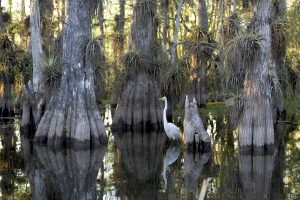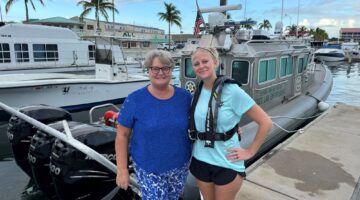Algae plaguing Florida’s iconic springs triggers legal fight
By KEVIN SPEAR, Orlando Sentinel undefined
ORLANDO, Fla. (AP) — Soon after taking office, Gov. Ron DeSantis promised long-awaited fixes for the ailing Everglades, the green slimes at the waterfronts of Stuart and Martin County and the red tides along Sarasota and Fort Myers.
Those aquatic disasters have rallied broad alliances of environmentalists, anglers, waterfront homeowners, motel and restaurant owners, boaters, beachgoers and local politicians in the heavily populated bottom half of Florida.
Meanwhile, the majority of the state’s hundreds of springs — a collection unlike anywhere else in the world — are confined largely to rural and less-affluent places north of Interstate 4, Orlando and Tampa Bay, and often are secluded in woods or wetlands at the end of a quiet county road.
For environmentalists taking on the state over springs in a costly legal challenge, politics haven’t tipped in their favor.
Clay Henderson, executive director at Stetson University’s Institute for Water and Environmental Resilience, said authorities, with a nod from the new governor, could regroup and revise their springs strategy.
Otherwise, environmentalists say, what remains is a do-or-die fight.
The trouble is excessive growth of algae feeding on — as documented by authorities — pollution seeping into groundwater from septic tanks, sewage systems, agricultural and lawn fertilizer and stormwater.
Once jewels of blue water, neon-green eelgrass and brilliant-white sand, Florida springs typically have been rendered darkly slimy.
“We have plans in place that are aggressive,” said Tom Frick, the Florida Department of Environmental Protection’s director of restoration, describing for lawmakers recently how premier springs are targeted for rehabilitation within 20 years.
But many citizens groups have labeled the state’s approach as so feeble for regulations, projects and funding it would lead to further degradation of springs even if it succeeded as designed.
Their legal challenge, to be conducted in September as a state hearing, will be immersed in pollution rates, sources and remedies, Floridan Aquifer dynamics and nature’s limits.
But there are basic issues, participants say.
Veteran environmental lawyer John Thomas, working with the Florida Springs Council, said authorities have shown little will for stemming agricultural and septic-tank pollution and no urgency for necessary spending on restoration measures.
The state’s plan is an “inventory and not a corrective tool,” Thomas said.
Here are snapshots from five of Florida’s most revered springs that are at the center of the unfolding battle.
BLUE SPRING
Early on a calm, winter weekday is when Cora Berchem, a researcher and multimedia specialist with Save the Manatee Club, most enjoys Blue Spring in Volusia County.
The spring and its stream are closed to swimmers, there are no noisy picnics, mist is rising from the water and she can hear a chorus of dozens or hundreds of manatees breathing.
“It’s really, really nice,” Berchem said.
But she knows that Blue Spring — next to the St. Johns River at the south end of DeLand and critical winter habitat for manatees — is ailing. Its flow is in decline and polluted.
The springs challenge filed by Save the Manatee Club asserts that the state’s pollution-reduction plans for Blue Spring are “based on projects that contain no specific planning information beyond ‘not provided’ or “TBD.”
Completion dates are sparse and funding is not identified, according to the challenge.
For those reasons and others the state’s plan “therefore drastically overestimates the benefit to the springs,” the challenge states.
Berchem said Blue Spring’s role as winter habitat for manatees was obvious on a cold day in late January when 558 of the animals took refuge in the spring and its run.
“People look at the springs now and to them it’s beautiful,” said Berchem, who has historic photos from before the algae plague.
“I worry that if don’t do something about it now, if we don’t address it soon, we may be too late,” she said.
ICHETUCKNEE SPRINGS
John Jopling, president of the Ichetucknee Alliance, wears a ball cap monogrammed on the back with: “BRINGING BACK THE BLUE.”
That had been the color of the water — flowing over white sand — at Ichetucknee Springs, which has long been a rite of outdoor exuberance for students driving a little more than 30 minutes from the University of Florida in Gainesville.
The Ichetucknee and its run remain a Florida paradise, a visual feast of wetlands embracing a meandering stream.
But the water’s primary color is inky dark from algae.
“It just about makes me weep,” said Jopling, who was born in Lake City and is a UF law graduate who practices in Gainesville. His group is challenging the state’s cleanup plans for the springs.
The suspected chief source of pollution is the extensive agriculture surrounding the springs. The Ichetucknee Alliance contends that the state’s cleanup plan does not go far enough.
But Jopling thinks Ichetucknee Springs, because it is not as degraded as other springs, could serve as an example and inspiration for springs restoration elsewhere.
“It’s relatively salvageable,” Jopling said. “This water could be blue again.”
MANATEE SPRINGS
Manatee Springs, at the Suwannee River in the remote Big Bend region, is strikingly scenic.
The state park there has a long boardwalk along the springs that extends through deep-swamp cypress, with turnouts for scenery and views of water snakes coiled on roots, to the Gulf of Mexico-bound Suwannee River.
The boardwalk is where the talkative, contrarian and gentlemanly Whitey Markle ripped the state for not better protecting his deceased mother’s favorite spring in all of Florida.
As a youngster, Markle was a “nut” for diving and swimming, he said. In the 1950s, his parents drove the Jacksonville family to a lot of springs, including to as far as the Panhandle’s DeFuniak Springs.
The sand beneath Manatee Springs’ water, he said, was “snow white.” It was what his mother cherished, and it’s gone now.
Now, Manatee Springs, surrounded by agriculture, is heavily polluted and is often a petri dish of big, green blobs of algae and slime that coats the once-pristine sand bottom.
Markle is chair of the Suwannee/St. Johns Sierra Club Group, which has joined the legal fight against the state.
“We’ve listened to these (state) guys say ‘we’ve got the fix and here it is,'” Markle said. “What are we supposed to think? It’s all bull.”
SILVER SPRINGS
East of Ocala at the edge of the Ocala National Forest and one Florida’s earliest tourist attractions as a steamboat destination, Silver Springs is where Capt. Karen Chadwick first got a sense of her calling.
She was four years old in 1963 when her mother took her on a glass-bottom boat ride. Her mother had to grasp Chadwick’s arms.
“I really, really wanted to touch the motor,” Chadwick said. “I really wanted to drive the boat.”
That’s her occupation now, operating her own tour boat on the waters of Central and North Florida, with Silver Springs and Silver River being her home base.
She became deeply committed to the springs and river after taking a job in 1990 at Silver River Museum, creation and setting up exhibits.
In the years that followed, she watched as the Silver Springs system, with nearly 30 springs and one of the largest such groups in Florida, grew dark and often choked with algae.
Chadwick is a member of the Silver Springs Alliance, which is challenging the state’s spring plan.
The group is asserting that the state would do far too little with septic tanks, lawn fertilizer and agricultural pollution.
“There is too much wiggle room,” Chadwick said. “It’s just a dog-and-pony show.”
WEKIWA SPRINGS
Wekiwa Springs is the centerpiece of more than two dozen springs, including Rock Springs, that feed 42 miles of the Wekiva River and tributaries that hydrate a forested landscape larger than the city of Orlando.
The main springs is at the bottom of a grassy slope, appearing as the aquatic stage of a natural amphitheater.
The natural pool churns with swimmers on hot days, swimmers who happen to break apart a relentless growth of algae.
The concentration of nutrient pollution in the spring water is three to four times the amount that the aquatic ecosystem can tolerate and be healthy, according to state authorities.
“It’s never going to come back to the way it was,” said William Eggers, a member of Friends of the Wekiva River, which submitted one of the legal challenges.
The 37-year-old group, while instrumental in securing many of the state protections for the springs and river, is not large and is actively seeking donations for the legal fight and “any amount will help.”
“We can do a lot more to be better stewards of it and bring it back as much as possible,” said Eggers, a professional water ecologist and consultant.
He said the state has presented a clean-up plan with inexplicable math, initiatives that exist as little more than wish-list concepts and restoration projects that are neither difficult nor costly.
“They’ve taken all of the low hanging fruit,” Eggers said. “The real work has to start to get to the point where you don’t see algae covering the bottom.”
___
Information from: Orlando Sentinel, http://www.orlandosentinel.com/










No Comment